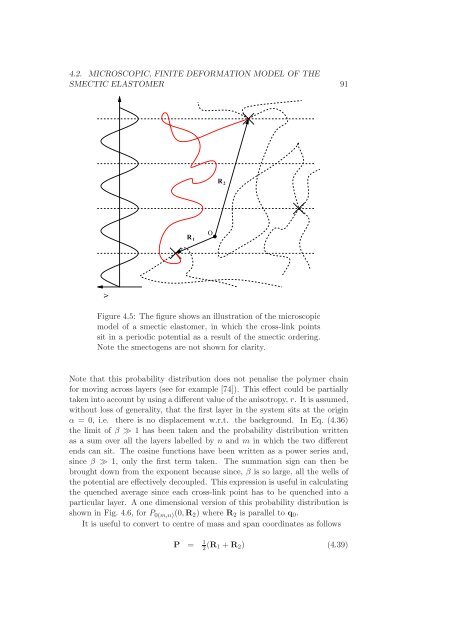Statistical models of elasticity in main chain and smectic liquid ...
Statistical models of elasticity in main chain and smectic liquid ...
Statistical models of elasticity in main chain and smectic liquid ...
You also want an ePaper? Increase the reach of your titles
YUMPU automatically turns print PDFs into web optimized ePapers that Google loves.
4.2. MICROSCOPIC, FINITE DEFORMATION MODEL OF THESMECTIC ELASTOMER 91R 2R 1OVFigure 4.5: The figure shows an illustration <strong>of</strong> the microscopicmodel <strong>of</strong> a <strong>smectic</strong> elastomer, <strong>in</strong> which the cross-l<strong>in</strong>k po<strong>in</strong>tssit <strong>in</strong> a periodic potential as a result <strong>of</strong> the <strong>smectic</strong> order<strong>in</strong>g.Note the smectogens are not shown for clarity.Note that this probability distribution does not penalise the polymer cha<strong>in</strong>for mov<strong>in</strong>g across layers (see for example [74]). This effect could be partiallytaken<strong>in</strong>toaccount byus<strong>in</strong>gadifferentvalue<strong>of</strong>theanisotropy, r. Itisassumed,without loss <strong>of</strong> generality, that the first layer <strong>in</strong> the system sits at the orig<strong>in</strong>α = 0, i.e. there is no displacement w.r.t. the background. In Eq. (4.36)the limit <strong>of</strong> β ≫ 1 has been taken <strong>and</strong> the probability distribution writtenas a sum over all the layers labelled by n <strong>and</strong> m <strong>in</strong> which the two differentends can sit. The cos<strong>in</strong>e functions have been written as a power series <strong>and</strong>,s<strong>in</strong>ce β ≫ 1, only the first term taken. The summation sign can then bebrought down from the exponent because s<strong>in</strong>ce, β is so large, all the wells <strong>of</strong>the potential are effectively decoupled. This expression is useful <strong>in</strong> calculat<strong>in</strong>gthe quenched average s<strong>in</strong>ce each cross-l<strong>in</strong>k po<strong>in</strong>t has to be quenched <strong>in</strong>to aparticular layer. A one dimensional version <strong>of</strong> this probability distribution isshown <strong>in</strong> Fig. 4.6, for P 0(m,n) (0,R 2 ) where R 2 is parallel to q 0 .It is useful to convert to centre <strong>of</strong> mass <strong>and</strong> span coord<strong>in</strong>ates as followsP = 1 2 (R 1 +R 2 ) (4.39)
















